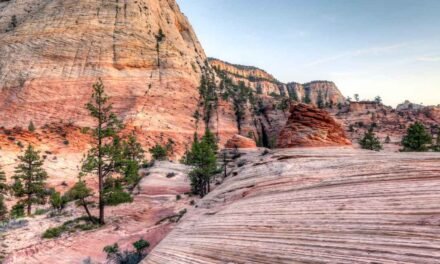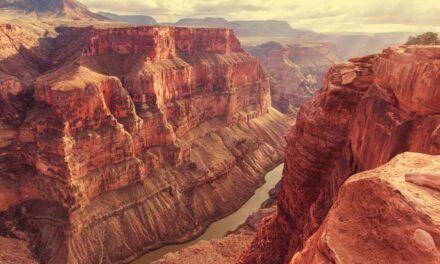The Grand Canyon, one of the world’s most awe-inspiring natural wonders, offers visitors a unique opportunity to explore millions of years of geological history. In this guide, we’ll delve into the geological processes that have shaped the Grand Canyon and highlight some of the best spots within the park where you can witness these processes in action.
Formation of the Grand Canyon
The Role of the Colorado River
The formation of the Grand Canyon is primarily attributed to the erosive power of the Colorado River, which has been carving its way through the Colorado Plateau for the past six million years. As the river cuts deeper into the plateau, it reveals a stunning array of rock layers, each representing a unique period in the region’s geological history. This process of erosion has created the canyon’s dramatic landscape, which extends for over 277 miles in length, up to 18 miles in width, and over a mile in depth.
Plate Tectonics and Uplift
While the Colorado River has played a crucial role in carving the Grand Canyon, the story of its formation would be incomplete without mentioning the impact of plate tectonics and uplift. The uplift of the Colorado Plateau, which began around 70 million years ago, has caused the river to cut more deeply into the landscape, exposing the layers of rock beneath the surface. This uplift, combined with the erosive power of the river, has resulted in the spectacular scenery that we see today.
Geological Processes in the Grand Canyon
Deposition
Deposition is the process by which sediments, such as sand, silt, and clay, are transported by water, wind, or ice and then accumulate in a new location. In the Grand Canyon, deposition has played a significant role in creating the distinctive rock layers visible in the canyon walls. Over millions of years, these layers were formed as sediments were deposited in various environments, including ancient seas, swamps, and deserts.
Where to See Deposition in Action
One of the best places to observe the results of deposition is along the Bright Angel Trail, which descends from the South Rim to the Colorado River. As you hike this trail, you’ll pass through numerous rock layers that represent different depositional environments. For example, the Tapeats Sandstone, found near the bottom of the trail, was deposited by an ancient sea, while the Hermit Formation, found higher up, was formed in a coastal swamp environment.
Erosion
Erosion is the process by which rock, soil, or other geological materials are gradually worn away by natural agents, such as water, wind, or ice. In the Grand Canyon, erosion has been instrumental in shaping the landscape and exposing the rock layers beneath the surface. The Colorado River’s relentless flow has worn away vast amounts of rock, creating the deep and winding canyon that we see today.
Where to See Erosion in Action
One of the best places to witness erosion at work is at the various viewpoints along the South and North Rims of the canyon. These overlooks provide stunning panoramas of the canyon, where you can see how the Colorado River has sculpted the landscape over millions of years. Additionally, the park’s many trails, such as the South Kaibab and North Kaibab trails, offer up-close views of the erosive forces that continue to shape the canyon.
Weathering
Weathering is the process by which rocks are broken down into smaller pieces due to exposure to the elements, such as temperature fluctuations, water, and wind. In the Grand Canyon, weathering plays a significant role in the formation of the canyon’s iconic cliffs, buttes, and spires. Both mechanical and chemical weathering contribute to the breakdown of the rock layers, creating the stunning geological features that make the park famous.
Where to See Weathering in Action
One of the best places to observe weathering in the Grand Canyon is at the iconic rock formations like the Battleship, visible from the South Rim’s Maricopa Point, or the Vishnu Temple, which can be seen from the North Rim’s Cape Royal viewpoint. These distinctive features have been shaped by millions of years of weathering, showcasing the power of natural forces in sculpting the canyon’s landscape.
Geologic Time Scale and Rock Layers
The Grand Canyon offers a fascinating window into the Earth’s geological history, with rock layers that span nearly two billion years. Each layer represents a distinct time period and tells a unique story about the environment and conditions that existed during its formation.
Precambrian Rocks: The Ancient Foundation
The oldest rocks in the Grand Canyon date back to the Precambrian Era, which spans from the formation of the Earth around 4.6 billion years ago to approximately 541 million years ago. The Vishnu Basement Rocks, which include the Vishnu Schist and Zoroaster Granite, are the foundation upon which the canyon’s younger layers were deposited. These ancient rocks can be seen at the bottom of the Inner Gorge along the Colorado River.
Paleozoic Rocks: A Time of Seas, Deserts, and Swamps
Above the Precambrian rocks, the canyon’s Paleozoic layers tell the story of an ever-changing environment, with ancient seas, deserts, and swamps leaving their mark on the landscape. Some of the most well-known layers from this time period include the Tapeats Sandstone, Bright Angel Shale, and Redwall Limestone. These layers can be seen at various locations throughout the park, such as along the Bright Angel and South Kaibab trails.
Missing Mesozoic and Cenozoic Layers: The Great Unconformity
One of the most intriguing geological features in the Grand Canyon is the Great Unconformity, which represents a significant gap in the rock record. Although rocks from the Mesozoic and Cenozoic eras are found elsewhere in the region, they are conspicuously absent from the canyon’s walls. This is due to a combination of erosion and non-deposition, which has left a gap of several hundred million years in the canyon’s geological history. The Great Unconformity can be observed along the park’s trails and at various viewpoints, such as Mather Point on the South Rim.
Conclusion
From its dramatic cliffs and buttes to its colorful rock layers, the geology of Grand Canyon National Park offers visitors a unique opportunity to explore the Earth’s ancient history. By understanding the geological processes that have shaped the canyon and knowing where to look for evidence of these processes, you can gain a deeper appreciation for this natural wonder and its place in our planet’s long and fascinating history.



